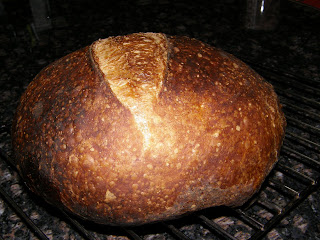



These pictures are of the first try of the Almost No Knead Bread recipe as found in the January-February 2008 issue of Cooks Illustrated. Kenje Alte was not impressed by the No Knead Bread recipe given in the November 2006 New York Times by Mark Bittman based on a recipe by Jim Lahey of the Sullivan Street Bakery in Manhattan. We have all seen this recipe and I tried it with distinct failing results. My endeavour had huge holes, didn't rise and didn't taste all that good. When I got the Cooks Illustrated magazine (I subscribe) it was the first one to try.
The Almost No Knead Bread recipe uses beer and white vinegar to make the bread taste better with somewhat of a sourdough flavor. The recipe was made using Gold Medal Harvest King flour which I like for the artisan breads. I used part of a bottle of Tyskie beer, a lager much like Budweiser, but with a slightly fuller flavor. The beer was part of a package of European beers I got for the Thanksgiving holidays. I don't normally drink anything this good. The remainder of the bottle did not go to waste! For the vinegar, I used plain white distilled vinegar.
The recipe produces a dough with a lower hydration than the original. For the 15 ounces of flour, I used 197 grams of water and 93 grams of beer. I kneaded the bread for about 3 minutes after the first rise. The dough felt right. Then I dropped it into a pan lined with a large sheet of parchment and let it rise for another 2 hours.
I heated my new dutch oven (without legs that get in the way) to 500 oF, and then slashed and transfered the loaf into the hot kettle, covered it and put it back into the oven, and reset the temp to 425 oF for 30 minutes. When that time was up, I followed the instructions to remove the lid and continue to bake the loaf uncovered until it is deep brown and the instant read thermometer reads 210. I used a remote thermometer and it did not reach 210 oF before the loaf got too brown. The second picture shows the bottom of the loaf. My thermometer read 205 oF.
When I removed the lid and inserted the thermometer, it read 203 and the loaf was nicely browned, but not dark brown. I should have removed it from the oven at that time.
The crumb is what I expected, nicely formed with relatively large holes. It has a chewy texture and a good flavor. The dark brown crust was too hard. (It knocked off a couple of small pieces of a tooth that broke three days ago and now has a temp filling waiting for a new crown. My teeth are getting older than I am.)
This bread is good. I will make it again.
I would give you the recipe, but you should buy the magazine for it. Cooks Illustrated, No. Ninety, Jan-Feb 2008. There are oranges on the cover.


3 comments:
I tried this recipe as well and found it to be very good, a distinct improvement on the original no-knead recipe. I think the addition of the vinegar and beer really helped with the flavor, and the lower hydration was also welcome. I just finished mixing up the dough for my second batch of this recipe.
I love reading your experience with Cook's latest No Knead recipe. I am about to try it myself. I thought of myself as a pretty experienced breadmaker until today. (I have kept a starter alive for a decade and made a good family wheat bread and a few variations nearly weekly.) My experience has taught me to bake based more on feel and texture than on exact measure the like. I suppose it is more critical when you are trying to make the bread in such a short time. How are you measuring the liquids? Are these volume amounts or weights? I haven't gotten the magazine yet, will get it tomorrow. Got interested by watching the video on itunes today.
Emily asked how I measure the liquids. I use a measuring cup and I weigh liquids, depends on what I am making. Odd ratios bring out the scale and regular recipes tend to use the Pyrex measuring cups. Either way, it is fun!
Post a Comment